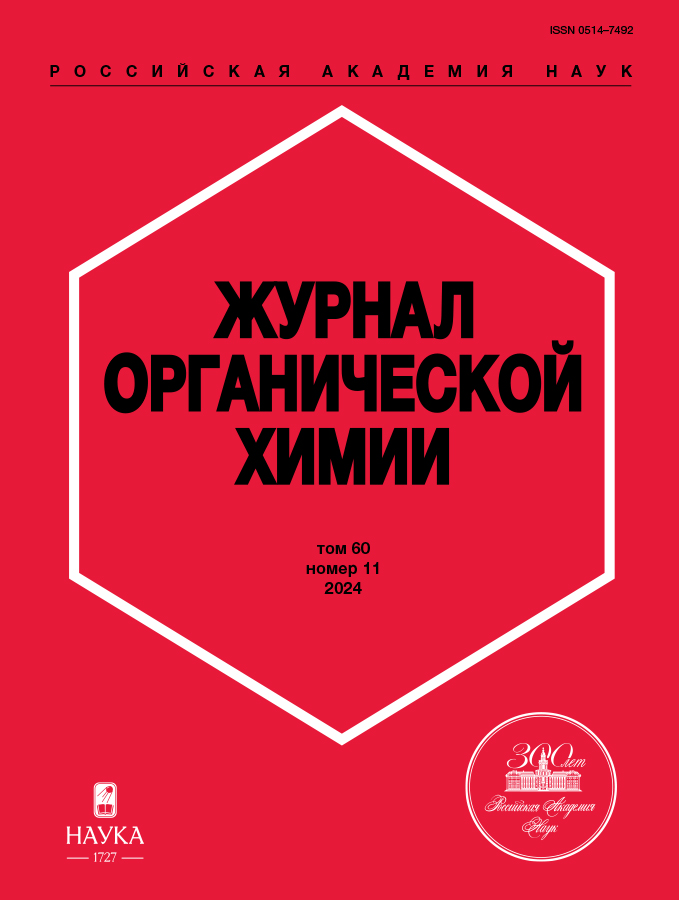Mass Spectra of New Heterocycles: XXVII. Investigation of Polysubstituted 4,4'-Dipyrromethanes by Electron Ionization
- Autores: Klyba L.V.1, Sanzheeva E.R.1, Nedolya N.А.1, Tarasova O.A.1
-
Afiliações:
- A.E. Favorsky Irkutsk Institute of Chemistry, Siberian Branch of the Russian Academy of Sciences
- Edição: Volume 60, Nº 11 (2024)
- Páginas: 1091-1100
- Seção: Articles
- URL: https://rjpbr.com/0514-7492/article/view/682491
- DOI: https://doi.org/10.31857/S0514749224110011
- EDN: https://elibrary.ru/QHXODA
- ID: 682491
Citar
Texto integral
Resumo
Behavior of a wide range of previously unknown polysubstituted 4,4'-dipyrromethanes, namely 1,1'-bis{1-[2-(vinyloxy)ethyl]-2-amino-5-sulfanyl-1H-pyrrole-4-yl}ethanes, synthesized in one preparative stage from propargylamines, 2-(vinyloxy)ethyl isothiocyanate, and alkylating agents, under the action of electron ionization (70 eV) was studied for the first time. The studied compounds form a stable molecular ion {with the exception of 5.5'-di[(allyl-, propargyl-, and cyanomethyl)sulfanyl]dipyrromethanes}, the primary fragmentation of which proceeds in three directions with the formation of four key cations. Two of them (ions [M − R1]+ and [M − SR1]+) are associated with the breaking of C−S bonds in the sulfanyl substituent and between the latter and the pyrrole cycle. The third direction is due to the cleavage of the C−C bond between the pyrrole cycle and the methylene bridge linking the pyrrole cycles. In this case, two cations are formed, the peak intensity of which in the mass spectra ranges from 3 to 100% (depending on the structure of the substituents). The peaks of cation radicals [(M − R1) − SR1]+• have the highest intensity (up to 100%). The resulting fragmentation ions are stabilized as a result of cyclization with the participation of a vinyloxyethyl substituent.
Palavras-chave
Texto integral
Sobre autores
L. Klyba
A.E. Favorsky Irkutsk Institute of Chemistry, Siberian Branch of the Russian Academy of Sciences
Autor responsável pela correspondência
Email: klyba@irioch.irk.ru
ORCID ID: 0000-0002-5521-3201
Rússia, Favorsky St., 1, Irkutsk, 664033
E. Sanzheeva
A.E. Favorsky Irkutsk Institute of Chemistry, Siberian Branch of the Russian Academy of Sciences
Email: klyba@irioch.irk.ru
ORCID ID: 0000-0002-9776-2794
Rússia, Favorsky St., 1, Irkutsk, 664033
N. Nedolya
A.E. Favorsky Irkutsk Institute of Chemistry, Siberian Branch of the Russian Academy of Sciences
Email: klyba@irioch.irk.ru
ORCID ID: 0000-0003-2614-7265
Rússia, Favorsky St., 1, Irkutsk, 664033
O. Tarasova
A.E. Favorsky Irkutsk Institute of Chemistry, Siberian Branch of the Russian Academy of Sciences
Email: klyba@irioch.irk.ru
ORCID ID: 0000-0003-4895-3217
Rússia, Favorsky St., 1, Irkutsk, 664033
Bibliografia
- Клыба Л.В., Санжеева Е.Р., Недоля Н.А., Тарасова О.А. ЖОрХ. 2023, 59, 895–903. [Klyba L.V., Sanzheeva E.R., Nedolya N.A., Tarasova O.A. Russ. J. Org. Chem. 2023, 59, 1136–1143.] doi: 10.1134/S1070428023070035
- Lindsey J.S. Synthesis of meso-Substituted Porphyrins, In: The Porphyrin Handbook; Eds. Kadish K.M., Smith K.M., Guilard R., Academic Press: San Diego, 2000, 1, Chapter 2, 45−118.
- Sessler J.L., Gebauer A., Weghorn S.J. Expanded porphyrins, In: The Porphyrin Handbook; Eds. Kadish K.M., Smith K.M., Guilard R., Academic Press: San Diego, 2000, 2, Chapter 9, 55−124.
- Paolesse R. Syntheses of Corroles, In: The Porphyrin Handbook. Eds. Kadish K.M., Smith K.M., Guilard R., Academic Press: San Diego, 2000, 2, Chapter 11, 201−232.
- Panda P.K., Lee C.-H. Org. Lett. 2004, 6, 671−674. doi: 10.1021/ol0360750
- Sessler J.L., Gale P.A. Calixpyrroles: Novel anion and neutral substrate receptors, In: The Porphyrin Handbook, Eds. Kadish K.M., Smith K.M., Guilard R., Academic Press: San Diego, 2000, 6, Chapter 45, 257−278.
- Loudet A., Burgess K., Chem. Rev. 2007, 107, 4891−4932. doi: 10.1021/cr078381n.
- Haugland R.P. The Handbook. A Guide to Fluorescent Probes and Labeling Technologies, 10th Edn.; Molecular Probes, Inc.: Eugene, Oregon, 2005.
- Sobenina L.N., Vasil’tsov A.M., Petrova O.V., Petrushenko K.B., Ushakov I.A., Clavier G., Meallet-Renault R., Mikhaleva A.I., Trofimov B.A. Org. Lett. 2011, 13, 2524−2527. doi: 10.1021/ol200360f
- Pan Z.-H., Luo G.-G., Zhou J.-W., Xia, J.-X., Fang K., Wu R.-B. Dalton Trans. 2014, 43, 8499−8507. doi: 10.1039/C4DT00395K.
- Kosswattaarachchi A.M., Friedman A.E., Cook T.R. Chem. Sus. Chem. 2016, 9, 3317−3323. doi: 10.1002/cssc.201601104.
- Lazzeri D., Durantini E.N. ARKIVOC 2003, (x), 227−239. doi: 10.3998/ark.5550190.0004.a23
- Abrahamse H., Hamblin M.R. Biochem. J. 2016, 473, 347−364. doi: 10.1042/BJ20150942.
- Bonnett R. Chem. Soc. Rev. 1995, 24, 19−33. doi: 10.1039/CS9952400019
- Pass H.I. J. Natl. Cancer Inst. 1993, 85, 443−456. doi: 10.1093/jnci/85.6.443
- Ak M., Gancheva V., Terlemezyan L., Tanyeli C., Toppare L. Eur. Polym. J. 2008, 44, 2567−2573. doi: 10.1016/j.eurpolymj.2008.06.027
- Susmel S., Comuzzi C. RSC Adv. 2015, 5, 78379−78388. doi: 10.1039/C5RA16129K
- Sharma A., Obrai S. Chem. Sinica, 2015, 6, 57−66.
- Gale P.A., Lee C.-H. Top. Heterocycl. Chem. 2010, 24, 39−73. doi: 10.1007/7081_2010_30
- Pereira N.A.M., Pinho e Melo T.M.V.D. Org. Prepar. Proced. Int. 2014, 46, 183−213. doi: 10.1080/00304948.2014.903140
- Nedolya N.A., Tarasova O.A., Albanov A.I., Klyba L.V., Trofimov B.A. J. Org. Chem. 2024, 89, 864–881. doi: 10.1021/acs.joc.3c01732
- Клыба Л.В., Недоля Н.А., Тарасова О.А., Санжеева Е.Р. ЖОрХ. 2013, 49, 398−404. [Klyba L.V., Nedolya N.A., Tarasova O.A., Sanzheeva E.R. Russ. J. Org. Chem. 2013, 49, 384−390.] doi: 10.1134/S1070428013030123
- Клыба Л.В., Недоля Н.А., Тарасова О.А., Санжеева Е.Р. ЖОрХ. 2014, 50, 43−51. [Klyba L.V., Nedolya N.A., Tarasova O.A., Sanzheeva E.R. Russ. J. Org. Chem. 2014, 50, 35−44.] doi: 10.1134/S1070428014010072
- Клыба Л.В., Недоля Н.А., Санжеева Е.Р., Тарасова О.А., Шагун В.А. ЖОрХ. 2019, 55, 1857−1869. [Klyba L.V., Nedolya N.A. Sanzheeva E.R., Tarasova O.A., Shagun V.A. Russ. J. Org. Chem. 2019, 55, 1853−1863.] doi S1070428019120078
- Клыба Л.В., Недоля Н.А., Санжеева Е.Р., Тарасо-ва О.А. ЖОрХ. 2020, 56, 711−718. [Klyba L.V., Nedolya N.A., Sanzheeva E.R. Tarasova, O.A. Russ. J. Org. Chem. 2020, 56, 768−774.] doi: 10.1134/S1070428020050073
- Клыба Л.В., Недоля Н.А., Санжеева Е.Р., Тарасо-ва О.А. ЖОрХ. 2021, 57, 363−372. [Klyba L.V., Nedolya N.A., Sanzheeva E.R., Tarasova O.A. Russ. J. Org. Chem. 2021, 57, 347−354.] doi: 10.1134/S1070428021030040
- Клыба Л.В., Недоля Н.А., Санжеева Е.Р., Тарасова О.А. ЖОрХ. 2021, 57, 1669−1683. [Klyba L.V., Nedolya N.A., Sanzheeva E.R., Tarasova O.A. Russ. J. Org. Chem. 2021, 57, 1901−1912.] doi: 10.1134/S1070428021120022
Arquivos suplementares





















